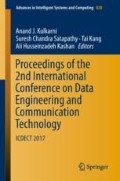Abstract
Treatment in oncology relies heavily on imaging. Automatic identification of cancerous tumors is a challenging and time-taking task. This paper presents a multi-objective genetic algorithm for calculating optimal threshold value for binarization of CT lung images and segmentation of the tumor region using connected component analysis. The threshold determination method is tested on two public datasets: Data Science Bowl: Stage 1 and NSCLC lung cancer dataset. The results obtained are compared with other genetic algorithm approach and traditional Otsu’s method. The proposed method gives better threshold value compared to Otsu’s method and outperforms other genetic algorithm approach both in terms of threshold value and computation time. Connected component analysis is done on the labeled connected component in the binarized image. Based on predetermined geometric measurements, the components are marked as tumors and non-tumors. This method when applied to 240 cancerous images, correctly identified tumors for 205 images while showed no result where there are no tumors in the image.
Access this chapter
Tax calculation will be finalised at checkout
Purchases are for personal use only
References
Didkowska J, Wojciechowska U, Manczuk M, Lobaszewski J (2016) Lung cancer epidemiology: contemporary and future challenges worldwide. Ann Transactional Med 1–2
Noronha, V, Pinninti R, Patil VM, Joshi A, Prabhash K (2016) Lung cancer in the indian subcontinent. South Asian J Cancer 1–2
Over 17 lakh new cancer cases in India by 2020: ICMR, 19 May 2016. [Online]. Available: http://icmr.nic.in/icmrsql/archive/2016/7.pdf
The 2015 world health organization classification of lung tumors: impact of genetic, clinical and radiologic advances since the 2004 Classification. J Thoracic Oncol 1243, 10(9) 2015
American cancer society. Lung cancer (Non-small cell), American cancer society, 2016. [Online]. Available: https://www.cancer.org/content/dam/CRC/PDF/Public/8708.00.pdf
American Cancer Society. Lung Cancer (Non-Small Cell) American cancer society, 2016. [Online]. Available: https://www.cancer.org/content/dam/CRC/PDF/Public/8722.00.pdf
American cancer society. Lung cancer (Non-small cell). American cancer society, 2016. [Online]. Available: https://www.cancer.org/content/dam/CRC/PDF/Public/8703.00.pdf
Senthilkumaran N, Vaithegi S (2016) Image segmentation by using thresholding techniques for medical images. Comput Sci Eng: An Int J (CSEIJ) 6(1):1–4
Otsu N (1979) A threshold selection method from gray-level histogram. IEEE Trans Syst Man, and Cyber 9(1)
Sezgin M, Sankur B (2004) Survey over image thresholding techniques and quantitative performance evaluation. J Electron Imaging 13(1):146–165
Niblack W (1986) An introduction to digital image processing. Prentice Hall pp 115–116
Sauvola J, Peitikainen M (2000) Adaptive document image binarization. Pattern Recognitiion 33(2):225–236
John J, Mini MG (2015) Multilevel thresholding based segmentation and feature extraction for pulmonary nodule detection. In: International conference on emerging trends in engineering, science and technolgoy (ICETEST)
Manikandan S, Ramar K, Iruthayaraja MW, Srinivasagan KG (2014) Multilevel thresholding for segmentation of medical brain images using real coded genetic algorithm. Measurement 47:558–568
Banimelhem O, Yahya YA (2012) Multi thresholding image segmentation using genetic algorithm. Int J Adv Innovative Res 1(2)
Rajnikanth V, Aashiha JP, Atchaya A (2014) Gray-level histogram based multilevel threshold selection with bat algorithm. Int J Comput Appl 93
Raju PDR, Neelima G (2012) Image Segmentation by using histogram thresholding. IJCSET 2(1):776–779
Sheta A, Braik MS, Aljahdali S (2012) Genetic algorithms: a tool for image segmentation. In: IEEE
Aerts H, Velazquez E, Leijenaar R, Parmar C, Grossman P, Cavalho S, Lambin P (2014) Decoding tumour phenotype by non-invasive imaging using a quantitative radiomics approach. Nature Communications. Nature Publishing Group, no. June 3 2014
Aerts HJ, Rios Velazquez E, Leijenaar RT, Parmar C, Grossmann P, Carvalho S, Lambin P (2015) Data From NSCLC-radiomics-genomics. The Cancer Imaging Archive
Clark K, Vendt B, Smith K, Freymann J, Kirby J, Koppel P, Moore S, Philips S, Maffitt P, Tarbox L, Prior F (2013) The cancer archive (TCIA): maintaining and operating a public information repository. J Digit Imaging 26(6):1045–1057
Data science bowl 2017, Data science bowl, 2017. [Online]. Available: https://www.kaggle.com/c/data-science-bowl-2017/data
Acknowledgements
The work described in this paper is carried out under the research project “BIONIC: Big Imaging Data Approach for Oncology in a Netherlands India Collaboration,” funded by Ministry of Electronics and Information Technology, Government of India.
Author information
Authors and Affiliations
Corresponding author
Editor information
Editors and Affiliations
Rights and permissions
Copyright information
© 2019 Springer Nature Singapore Pte Ltd.
About this paper
Cite this paper
Choudhury, A., Subramanian, R.R., Sunder, G. (2019). A Novel Approach for Tumor Segmentation for Lung Cancer Using Multi-objective Genetic Algorithm and Connected Component Analysis. In: Kulkarni, A., Satapathy, S., Kang, T., Kashan, A. (eds) Proceedings of the 2nd International Conference on Data Engineering and Communication Technology. Advances in Intelligent Systems and Computing, vol 828. Springer, Singapore. https://doi.org/10.1007/978-981-13-1610-4_37
Download citation
DOI: https://doi.org/10.1007/978-981-13-1610-4_37
Published:
Publisher Name: Springer, Singapore
Print ISBN: 978-981-13-1609-8
Online ISBN: 978-981-13-1610-4
eBook Packages: EngineeringEngineering (R0)

